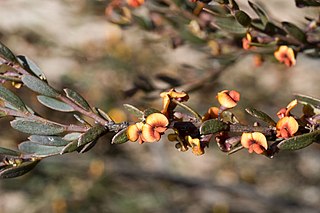
Pittosporaceae is a family of flowering plants that consists of 200–240 species of trees, shrubs, and lianas in 9 genera. Habitats range from tropical to temperate climates of the Afrotropical, Indomalayan, Oceanian, and Australasian realms. The type genus is Pittosporum Banks ex Gaertn.

Gastrolobium sericeum is a flowering plant in the family Fabaceae. It is endemic to the south-west of Western Australia. It is a prostrate, low shrub with pendulous yellow, green, red or nearly black pea-flowers from spring to summer.

Marianthus tenuis is a shrub of the pittosporum family, Pittosporaceae native to southwest Western Australia.
Lindy Webster Cayzer CF is an Australian botanist.

Bursaria occidentalis is a species of flowering plant in the family Pittosporaceae and is endemic to Western Australia. It is a spiny tree or shrub with egg-shaped adult leaves, flowers with relatively small, hairy sepals and five spreading creamy-white petals, and inflated capsules.

Daviesia argillacea is a species of flowering plant in the family Fabaceae and is endemic to the south-west of Western Australia. It is an erect, bushy shrub with erect narrow egg-shaped phyllodes with the narrower end towards the base, and yellow to orange and maroon flowers.
Daviesia audax is a species of flowering plant in the family Fabaceae and is endemic to the south-west of Western Australia. It is an erect shrub with scattered, erect, thick, rigid, sharply pointed phyllodes, and orange flowers with reddish-brown markings.

Daviesia bursarioides, commonly known as Three Springs Daviesia, is a species of flowering plant in the family Fabaceae and is endemic to a restricted part of the south-west of Western Australia. It is a straggling shrub with widely-spreading, spiny branches, scattered, flattened phyllodes, and yellow, deep pink and maroon flowers.
Bursaria calcicola is a species of flowering plant in the family Pittosporaceae and is endemic to a restricted area near Wombeyan Caves in New South Wales. It is a spiny, hairy, erect or sprawling shrub with clustered, narrowly elliptic to egg-shaped leaves, white flowers with triangular sepals, cream-coloured petals and flattened fruit.

Daviesia campephylla is a species of flowering plant in the family Fabaceae and is endemic to a restricted part of Western Australia. It is a low, spreading shrub with ascending branches, phyllodes shaped like looping caterpillars, and yellow flowers with faint red markings.

Bursaria reevesii is a species of flowering plant in the family Pittosporaceae and is endemic to a few places near Marlborough in Queensland. It is an erect or sprawling shrub with spiny side-shoots, egg-shaped adult leaves with the narrower end towards the base, flowers with five white petals, and rounded fruit.

Daviesia crassa is a species of flowering plant in the family Fabaceae and is endemic to the south-west of Western Australia. It is a compact, dense, glabrous shrub with densely crowded, thick, club-shaped phyllodes, and uniformly yellow flowers.

Daviesia cunderdin, commonly known as Cunderdin daviesia, is a species of flowering plant in the family Fabaceae and is endemic to a restricted area in the south-west of Western Australia. It is a compact, densely-branched shrub with scattered, elliptic to egg-shaped phyllodes, and uniformly red flowers.
Daviesia eurylobos is a species of flowering plant in the family Fabaceae and is endemic to the south-west of Western Australia. It is a spreading shrub with somewhat crowded, egg-shaped to elliptic phyllodes, and yellow and red flowers.

Daviesia glossosema, commonly known as maroon-flowered daviesia, is a species of flowering plant in the family Fabaceae and is endemic to a restricted area of south-western Western Australia. It is an erect shrub with tangled, spreading branches, cylindrical, sharply-pointed phyllodes, and unusually-shaped maroon flowers.

Daviesia megacalyx is a species of flowering plant in the family Fabaceae and is endemic to a restricted part of the south-west of Western Australia. It is an erect, glabrous shrub with scattered, leathery, elliptic phyllodes and apricot-coloured and deep pink flowers.
Daviesia microcarpa, commonly known as Norseman pea, is a species of flowering plant in the family Fabaceae and is endemic to two small areas of inland Western Australia. It is a sprawling shrub with tangled stems and crowded, needle-shaped, sharply-pointed phyllodes, and orange and pinkish-red flowers.

Daviesia retrorsa is a species of flowering plant in the family Fabaceae and is endemic to the south of Western Australia. It is a dense, tangled shrub with glabrous branchlets and leaves, scattered, needle-like, sharply pointed phyllodes turned backwards, and orange-yellow and red flowers.

Daviesia speciosa is a species of flowering plant in the family Fabaceae and is endemic to the south-west of Western Australia. It is a low, erect, spindly, glabrous shrub with needle-shaped phyllodes almost indistinguishable from the branchlets, and red flowers.
Daviesia umbonata is a species of flowering plant in the family Fabaceae and is endemic to the south-west of Western Australia. It is a bushy, openly-branched shrub with narrowly elliptic to narrowly egg-shaped, sharply pointed phyllodes and yellow and red flowers.
















